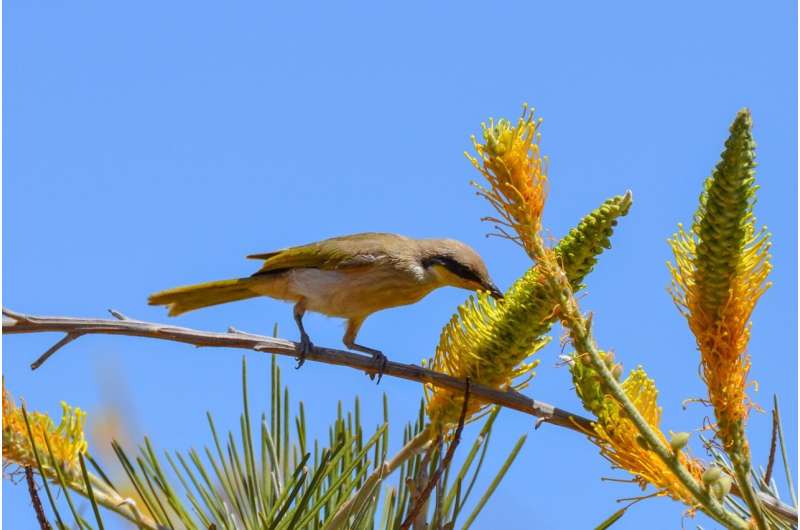This article has been reviewed according to Science X's editorial process and policies. Editors have highlighted the following attributes while ensuring the content's credibility:
fact-checked
preprint
trusted source
proofread
Shrinking birds change their tune: Birdsong may sound different in a warmer future

Birds' bodies are changing and so are their songs. Over the last 70 years, birds worldwide have been noticeably shrinking in mass or expanding in wing length.
Many scientists believe this to be a response to climate change. The changes increase birds' surface area to volume ratio, which allows heat to be released faster from their bodies.
But it also impacts how the birds communicate, including the very chirp of their songs.
Honey, we've shrunk the birds
Eleanor Hay recently completed her Ph.D. in trait evolution at Monash University's School of Biological Sciences. She's also a talented artist, illustrating many of the species she studies.
Ellie says we've known that many animals, including birds, have been universally getting smaller for a while now.
And small birds seem to be getting smaller faster.
"It's a trend that's been emerging in literature for a number of years," says Ellie.
"They've compared morphological traits of museum specimens over time and found many species are getting smaller.
"It means they're able to handle the heat better."
In her study of 163 honeyeater species, published on the pre-print server bioRxiv Ellie found that body size was the strongest predictor for changes in their songs.
Some of the species investigated include well-known WA locals like the noisy miner, New Holland honeyeater and white-naped honeyeater.
"Body size directly impacts the size of the vocal tract," says Ellie.
"And the sound-producing organs such as the syrinx.
"[Size] places a limit on the lowest frequency sound that a bird can produce."
Bigger vocal organs can vibrate at lower frequencies, producing lower-pitched sounds. Smaller, tighter surfaces vibrate more rapidly.
"We found that smaller birds produce higher-pitched songs," says Ellie.
Another factor that influences birds' song is the shape of their beak.
Birds with larger beaks are known to sing at a slower pace.
Ellie says environmental changes can have an evolutionary effect on beak shape, but the relationship is complex. Beaks are important for thermoregulation, so the shape can be influenced by external temperatures.
But beaks are also shaped by dietary choices, food availability and habitat complexity, which are, in turn, affected by environmental changes.
How quickly beaks change depends on how strong the various selection pressures are as well as how genetically diverse the population is to begin with.
Climate change can affect song-related behaviors too.
Associate Professor Mandy Ridley and Research Associate Mylene Dutour are from UWA's School of Biological Sciences. They recently co-authored an international study on the behavior of the great tit, a common songbird.
The study found that, in response to danger, the birds called out to each other less intensely and at lower volumes when temperatures were high.
"Great tits' survival is intertwined with their ability to communicate and respond to danger."
Drier conditions can also alter how birdsong is heard.
Songs travel further in moist air than in dry air.
A simulation of prairie environments in America found that many birds would not be able to effectively communicate with their neighbors in climate change-induced drought conditions.
This was especially the case for birds that live in large territories and sing at higher frequencies.
This is because high-frequency sounds can't bend easily around objects and dissipate more quickly than low-frequency sounds.
The researchers suggest increasing aridity would therefore favor a shift towards lower-frequency songs. But these might be difficult to achieve as birds' bodies—and vocal organs—get smaller.
Changes in birdsong could potentially affect birds' abilities to find mates, defend their territories and dodge predators.
Ellie says the exact implications are difficult to define.
"It's a very open-ended question," she says.
For now, it's worth paying attention to the songs of local birds and taking special note of your favorite tunes.
Because nature's playlist is about to get remixed.
More information: Eleanor M. Hay et al, Body size shapes song in honeyeaters, bioRxiv (2023). DOI: 10.1101/2023.06.20.545811
Journal information: bioRxiv
Provided by Particle



















